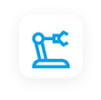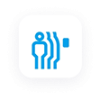The increasing adoption of autonomous robotics in various industries is inevitable. It has the potential to simplify industrial operations and optimize heavy-duty operations on a large scale, which is humanly impossible. Though extensive adoption may be limited to only certain industries, soon, every sector, even the ports, will employ autonomous technologies.
At present, almost 40 ports with partial or complete automation are operational worldwide. The trend is expected to continue as the autonomous technology and sensors used in the process mature.
But it doesn't imply that there aren't advanced autonomous sensors right now. The market is booming with innovation, and Hokuyo is at the forefront of it, building dependable, accurate, and multi-purpose sensors.
We have curated this guide to reveal the top sensors installed on ports and cranes to provide them with safe and efficient autonomous capabilities.
Which Sensors Are Used on Cranes & Ports?
Ports use special equipment, including cranes, made specifically for their operations. Understanding which types of cranes and equipment are integral to port functions is crucial before understanding the types of sensors that are compatible with them.
Crane Collision Avoidance Sensor
Such sensors are used to avoid collisions between two cranes. The sensor is mounted on the crane to detect the distance between itself and other objects, such as monorail systems. Overhead and gantry cranes are mostly equipped with this sensor.
Hokuyo's KAD-300 is an excellent example of a crane collision avoidance sensor. It can scan a distance of up to 100 feet and automatically initiates slow-down and stop commands.
The RSC-30LN is another industrial-grade collision avoidance sensor widely utilized in ports and on overhead cranes. It is mounted on the cranes deployed in the port to avoid crashing with fixed objects and also is ideal for high-bay to low-bay crane detection applications.
LiDAR/Obstacle Detection Sensor
The gantry cranes on the port shift containers from point A to point B. A LiDAR/obstacle detection sensor, such as URM-40LC-EWT is mounted on it to ensure it doesn't get smashed during that journey.
The sensor detects the presence of other items and stops the crane. Also, this sensor has a wide field of view of 270 degrees with a 40-meter detection range. So, nothing is out of sight, and there are zero chances of the crane or its load getting damaged.
Safety Laser Scanner
At busy shipping ports, personnel, automated guided vehicles and carts (AGVs), and autonomous mobile robots (AMRs) keep moving. They may all stand in each other's way, and accidents can happen.
So, to avoid such a hazardous situation, safety laser scanners are mounted on AMRs and AGVs so they are alerted about obstacles at a safe distance. The Hokuyo's UAM-05LP safety laser can detect obstacles from a 20-meter distance and has a 5-meter safety zone. The autonomous vehicle stops if an obstacle is detected in the safety zone.
Laser Distance Sensor
Taking measurements of various objects is a daily routine at the ports. However, doing the same manually takes time and effort. That is why laser distance sensors, such as the PGL series, are mounted on overhead and gantry cranes.
The sensor emits a laser that hits a surface, which can be natural, liquid, or reflector, and senses accurate distance between both. If that distance exceeds the prescribed limit, the sensor triggers a warning to avoid collision and alerts the designated department.
Hokuyo - Powering the Autonomous Robotics Industry With Continuous Innovation
The autonomous robotics industry is experiencing perpetual growth. The relentless emergence of novel and awe-inspiring inventions supports the upward growth and adoption rate trajectory. To support such a transformative cause, Hokuyo is dedicating itself to building industry-leading LiDAR rangefinders, obstacle avoidance sensors, and much more. We are constantly conducting industry-level research to understand the dynamic needs of every sector. We develop unconventional autonomous sensor solutions with superior performance based on our thorough research. Whether you want live surveillance or to equip your robot with real-time vision, we have the sensor you need. Connect with us to learn more about the range of sensors to meet the specific needs of your autonomous applications.

 Factory Automation
Factory Automation Logistics Automation
Logistics Automation Process Automation
Process Automation Crane Collision Avoidance
Crane Collision Avoidance LiDAR/Obstacle Detection
LiDAR/Obstacle Detection Safety Laser Scanners
Safety Laser Scanners Optical Data Transmission
Optical Data Transmission Hot Metal Detectors
Hot Metal Detectors Laser Distance Sensor
Laser Distance Sensor Blog
Blog Whitepapers
Whitepapers Case Studies
Case Studies Infographics
Infographics